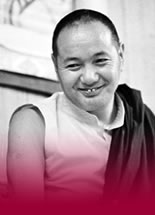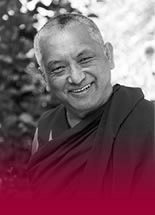Q & A with Robina
22 August, 2022
QUESTION
Dear Venerable Robina,
I’ve returned to my practice of Hatha Yoga this summer and I also had the chance to dedicate some time to reading about Indian History and Philosophy.
Some things came up for me that I want to clarify with you.
Hatha Yoga involves the practice of advanced pranayama. Pranayama literally means “vitality exertion,” “restraint of the vital energy,” or “restraint of prana.” The techniques involve complex breath work, mudras and bandhas, that can extend over several hours. The main treatise of Hatha Yoga (ha = sun, tha = moon, yoga = union of the two) is “The Hatha Yoga Pradipika,”commented on by the great yogi Svatmarama. It deals with the subtle body, working with the chakras and nadis, as well as with the kundalini shakti.
Interestingly enough, at the beginning of each practice the names of eighty-four mahasiddhas are chanted in Sanskrit, as taken from the Vedas. Even more interesting than that is that at least half if not more of these mahasiddhas correspond exactly to the Indian mahasiddhas revered in Tibetan Tantric Buddhism (the most prominent are Matsyendranath and Gorakshanath).
At the end of the book, yogi Svatmarama explains the greatest realization of Hatha Yoga: “mahaśunya,” “the great void,” or “the great emptiness.” He literally says that “mahaśunya” is the realisation of the lack of a limited, individual self, followed by the realisation of utter unity with all appearances, of complete fullness, due to which the mind of the yogi ultimately “transcends death.”
To me these elements seem completely in tune with how the Buddha himself describes emptiness and dependent arising.
Further on Svatmarama talks about how Hatha Yoga can be used in conjunction with Tantra. However, he notes that the safest path of practice is maintaining complete purity of body (through proper breathing, diet, and exercise), and mind, and not mix this with ingesting substances that are considered to be impure, nor reinforcing states of mind such as attachment and aversion. Basically, he says one should practice what is labelled as “Action Tantra” in Buddhism in conjunction with Hatha Yoga, and not Highest Yoga Tantra.
To me this has been a nagging question over the years: I see an utter compatibility between Buddhism and Hinduism when it comes down to these teachings! I adore the mahasiddhas, visualising these incredible beings, and invoking their protection is so meaningful in my practice. But I cannot separate them in my mind as strictly belonging to Buddhism, nor to Hinduism.
I keep thinking, maybe their ultimate, non-conceptual realisation was exactly the same, but when it came down to taking it down to a conceptual level:
1. the Advaita Vendanta yogis laid down the path of realising “atman and Brahman as nondual,” and put the work on the subtle body very early on the path, leaving the vows of conduct as secondary,
2. whereas the Buddha laid down the path in terms of “realising emptiness,” and put the vows of conduct as primary, setting the work on the subtle body at the very end of the path.
In any case, I would really like to know your thoughts on what I wrote to you today. It would mean a lot to get your perspective on the two approaches, on the ways in which you think they come together and grow apart.
I oftentimes think that the Vedic mahasiddhas must’ve been Buddhas too! Otherwise, without the ultimate realisation of the true nature of reality, how could one develop minor and major siddhis?
Thank you for going through my message and sending you all the best wishes,
N
ANSWER
I always enjoy reading your thoughts, dearest N.
Here’s one of my thoughts: if the great Indian yogis are coming to the same conclusion as the Buddha, why did he diverge from those views? All his extensive teachings on dependent arising are direct arguments with exactly those views. Why would he waste his time? That would be so arrogant!
And if the Advaita Vendanta yogis, for example, are saying the same as the Buddha, then they must have diverged from the previous Indian views.
So, for you, what to do with all this? Study it all — and practice! — and find out for yourself what is true and what is not. You have no choice but this.
You delight in finding common ground, and that’s marvelous. But it can be just attachment. Don’t be attached to any views, N — it’s the most dangerous attachment, I’d say. Rip them all to pieces! Truth will withstand that.
And we need to choose a path. We can’t look from above; we can’t put it all together intellectually.
Due to my propensities, I’ve chosen to take Lord Buddha’s views as expressed by Lama Tsongkhapa as my working hypothesis. And not only that, I’ve chosen the approach of my particular teachers, Lama Yeshe and Lama Zopa Rinpoche. And all I can do is go one step at a time. And as His Holiness says, if I discover from my own direct experience that what Buddha says is wrong, then I must reject him.
All I can say is, so far, so good. I can’t say more than that.
Much love,
Robina
QUESTION
Dear Venerable Robina,
Thank you for your answer.
You’re right, I am attached to looking to the Indian thought from above, and I do enjoy so much understanding where the Buddha came from and what made him come to his conclusions. I also enjoy seeing how multiple lineages took his teachings and emphasised a dominant aspect. Every time I find a common bridge between these approaches, I feel very happy and want to understand more.
But to tell you the truth, I find it difficult to stick to just one lineage and hold that as supreme. I would say that to the same extent that I value and respect Lama Tsongkhapa and his legacy, I respect Master Linji, Adi Shankara, and Svatmarama. It’s like they all speak of the same truth, but just with different voices, just like four people that have seen a big oak tree and each uses their own language to describe it.
Can you please tell me more about why you chose just one path and why you think it is important to stick with one lineage?
ANSWER
Dearest N,
I honestly think it’s the same approach with learning any body of knowledge. There’s the theory and then there’s the practice, and even if many theories lead to the same experience, we still have to choose one as a starting point. This is not being fundamentalist; it’s literally practical!
One music teacher will say to put your elbow this way and another will say to put it that way. How can you do both? Quite simply, it’s not possible. So you choose one and go deep down in that direction.
Then, once you’ve had some experience, you have the space and the wisdom to incorporate the other’s approach.
I fell into the lap of Lama Yeshe and Lama Zopa Rinpoche at my first course. I had no idea about Tibetan or Japanese Buddhism; Gelugpa or Nyingma. And I certainly had no idea about the different approaches of the various Gelug teachers. But I checked on these two teachers, felt confident, and followed their style.
Now I have not only many Gelug teachers but also teachers from various Tibetan traditions. I remember hearing the middle way teachings from Dzongsar Khyentse Rinpoche, one of my teachers, and it was fascinating to hear his very different approach. But I was able to distinguish the differences, which gave me such insight, and could then incorporate the advice into my practice.
I started with one style and now can hear many; I can hear the connections, the similarities. I would have been confused if I’d tried from day one to follow both instructions.
As I said, intellectually finding the similarities can be captivating. But until we actually jump in, we will never experience the taste of the teachings, never find the reality they point to.
Don’t fear losing something by choosing; that’s just attachment.
This is what I’ve found to be true, N.
Keep moving! Never give up!
Much love,
Robina

